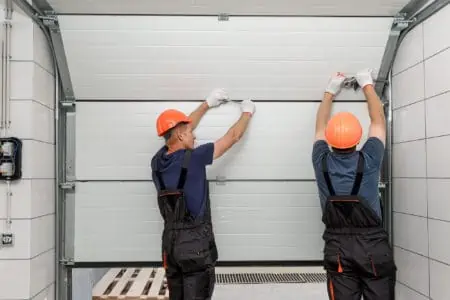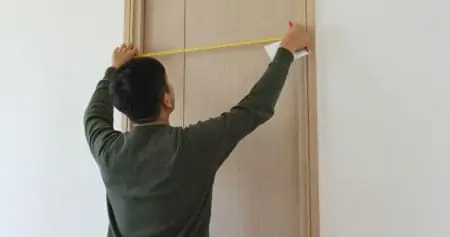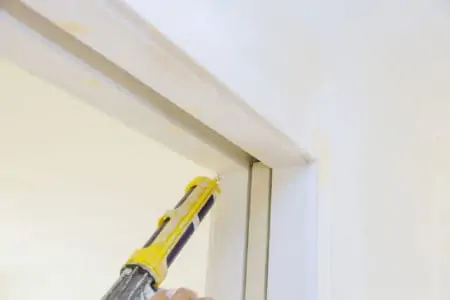When you open your garage door and hear a loud squeaking noise, it’s time to reach for the lubricant. It puts the mechanisms and springs under immense strain if you don’t, which could be costly further down the line.
Luckily, lubricating a garage door is simple enough. We show you how to lubricate a garage door and share tips to improve long-term maintenance.
Key Takeaways
- Lubricate garage door every six months with white lithium grease or silicone spray.
- Avoid using WD-40 as it attracts dirt and debris.
- Focus on hinges, rollers, bearing plates, springs, and armbar for lubrication.
- Maintain garage door by tightening bolts and screws, and checking the auto-reverse system.
Why Is My Garage Door So Noisy?
There are several reasons why your garage door squeaks like a mouse at a yodeling contest. It’s best to focus on simple things before we look at mechanical faults like bent tracks and broken springs.
The most likely cause is a lack of lubrication. Greasing the runners, tracks, springs, and chains is vital to keeping the door mechanism in good working order.
Another reason could be that the door needs some basic maintenance. You should complete a proactive fault checklist every six months. Be sure to include:
- Tightening nuts and bolts and checking that no movable parts are worn.
- Inspecting the rollers for wear and tear. The bearing in the wheels gathers dust over time and starts to break down. If this happens, they work loose and become harder to operate.
- Check for worn hinges because they can cause the door to bind as it opens.
- Tighten the garage door opener chain because a loose chain swings about, causing the door to sway when you open it.
- Check the tracks are straight. When the rollers move about in the tracks, they can cause them to bend and buckle.
Take Note
A grating sound indicates metal on metal, which could mean components, like the ones above, need adjustment. A squeaking noise tells you that you need more lubricant.
Best Lubricant for Garage Doors
Stop! Don’t reach for that well-known brand (admit that you know the one). WD-40 is such a popular household name, we’ve become a nation hooked on the idea that it is the best product.
While WD-40 does lubricate squeaky mechanisms, it is a water displacer first and only contains a small amount of lubricant. It is a wet solution, which is prone to attracting more dust and debris.
Likewise, mechanic’s grease and engine oil are also the wrong choices. So, we’ve talked about what you shouldn’t use, but what is the best lubricant?
Silicone Spray
Silicone sprays, like this 3M Silicone Lubricant (Dry Version), are easier to direct because they come with a long hose that attaches to the nozzle. They are great in any weather condition and stand up well to daily use.
More importantly, they don’t attract as much dust as WD-40 because of the dry formula.
White Lithium Grease
White lithium grease, like this Permatex Automotive Grease, is applied by spreading it with your fingers. So, while it lacks the precision of silicone spray, it is easier to get an even spread. It’s also thicker, so it adheres to metal surfaces, making it last longer.
How to Lubricate a Garage Door
Lubricating a garage door is pretty straightforward as long as you follow a maintenance checklist. However, you can’t get started until you gather the right tools and materials.
What You’ll Need
- Clean rag.
- Silicone and white lithium grease.
- Screwdriver (Phillips or flathead depending on the screws).
- Garage door remote.
- Vacuum cleaner.
- Stepladder.
- Auto brake cleaner.
1. Close the Garage Door
Use the door remote and ensure the garage door is completely closed. It allows you to access the door’s tracks and other mechanical parts.
2. Disconnect the Power
Once the door is closed, disconnect the power supply to the automatic door opener. You can either pull the plug or flip the breaker switch if the plug is too hard to reach.
3. Clean the Tracks
The tracks guide the door rollers, so while you want them clean, you don’t want them lubricated. Wet the rag and wipe down the inside of the tracks, removing all the dirt and debris. Use an auto brake cleaner for the stubborn dirt.
4. Use the Vacuum
Attach the hose and use the vacuum cleaner to get the stubborn dirt. A vacuum cleaner is also an excellent option for overhead tracks that are too high to reach.
5. Grab the Lithium or Silicone Grease
Never use oil or WD-40, as this will likely attract dirt to the door’s moving parts. You can buy dedicated garage door grease, like this GreaseCo Garage Door Lubricant, but invariably, it is more expensive.
White lithium grease or silicone grease works just as well and could save you money. These lubricants almost always come as an aerosol spray to make them easier to deploy in hard-to-reach places.
6. Start with Hinges
If you have a roller door, lift the door gradually, taking care to apply two sprays to each hinge. For up-and-over doors, coat the hinges on the side of the door where it pivots.
7. Lubricate the Rollers
Spray the grease into the bearing on the rollers. These consist of small ball bearings that need lubrication for the door to operate smoothly.
Good To Know
Avoid getting lubricant on the track. Lubrication causes the wheels to slip, which could damage the mechanism. As long as it is clear of debris, the rollers will run smoothly.
8. Bearing Plates and Springs
The springs are typically located at the top of the garage door, so you will need a stepladder to reach them. You will find the bearing plates on either side of the springs.
Apply the lubricant on the outside of the springs and the center of the bearing plate, and operate the garage door to spread the grease.
Serious Point
If the springs are damaged, don’t ignore them. Call in a professional to replace them.
9. Armbar and the Lock
Direct it into the lock using the hose attachment on your spray lubricant. Now do the same and coat the armbar at the top of the door. This prevents rusting and keeps all the lock parts working as they should.
10. Top of the Rail
The rail carries your garage door chain. It rides along the top portion, so it will need to be lubricated. Climb the step ladder and spray onto the top of the rail. Now spread the grease with a clean rag.
Important Point
This method may differ from your specific manufacturer’s instructions, so it’s always better to consult your manual first. Also, lubricating the underside of the rails is pointless because it does nothing.
How to Maintain a Garage Door
Keeping your garage door in working order is not just about dealing with repairs. You can save yourself a world of problems by adopting a maintenance program that keeps issues at bay.
Here are some useful tips to get you started:
Tighten Bolts and Screws
When inspecting your garage door and opening mechanism, grab a screwdriver and spanner to tighten all the loose nuts and screws. These elements work loose with daily use and could cause untold damage if left unchecked.
Look and Listen
One of the best ways to diagnose problems with your garage door is to use your eyes and ears. Watch how the door raises and lowers. Are both sides lifting evenly, and can you feel obstructions? Also, can you hear grinding noises or squeaking?
Even the smallest grinding noise could be a symptom of a much bigger problem.
Check the Auto-Reverse System
Automatic garage doors should have an auto-reverse feature. It works by activating pressure sensors or photocells on either side of the door. It detects obstacles in the way of the door and puts the mechanism into rewind to avoid accidents.
Lay a scrap piece of wood on the floor, directly below where the garage door closes. Operate the close option using the remote control. As the door descends and touches the wood, it should reverse.
To check the photoelectric sensors on either side of the door, start the close process and wiggle your leg in front of the door. Your leg should break the field between the sensors, and the door will open.
Check the Springs
One of the easiest tell-tale signs you have damaged springs is when the door raises or lowers at an angle. It indicates a failed spring. If left unchecked, your garage door will eventually become damaged.
It could even wear out the automatic opening mechanism, which will be extremely costly to repair.
FAQs
Don’t Ignore the Signs
We’ve all said we’d look at something later or put off a task until it was too late. Garage doors are expensive, especially coupled with the cost of automatic openers. Ignoring the warning signals only leads to tears down the line.
For the cost of some lithium grease and an afternoon’s work, you can keep your garage door working like a well-oiled machine, which means you can focus on other things.












